Quantification of Energy Flexibility and Survivability of All-Electric Buildings with Cost-Effective Battery Size: Methodology and Indexes
Abstract
1. Introduction
1.1. Building Electrification
1.2. Demand Response
1.3. Energy Flexibility
1.4. Innovative Contributions
- Load shift calculation of electric-based heating demand in response to different business models for dynamic pricing tariffs.
- Formulation of a model to determine the cost-effective battery size needed for storing the shifted load.
- Introduction of the concept of “active survivability” in the context of all-electric buildings.
- Introduction of new flexibility and survivability indexes for the comparison of the possible designs for an all-electric building under different dynamic pricing tariffs.
2. Methodology
2.1. Algorithm Input
2.1.1. Business Models for Dynamic Pricing Tariffs in Norway
- Measured power rate tariff model.
- Tiered rate tariff model.
- Time of use tariff model.
2.1.2. Building Models
2.2. Algorithm Development
2.2.1. Cost Calculation and Shift Analysis
- The ideal heat shift consists of the space heating and domestic hot water loads.
- The ideal heat shift will not sacrifice the occupant’s comfort (regarding space heating and domestic hot water).
- The storage of the shifted load is considered in a daily-based manner (kWh/day).
- No losses are considered during the ideal load shift.
- The energy rate tariff applies the same energy price during all hours of the year, so load shifting under this tariff will not be beneficial from the customer’s point of view. Even though shifting can remove the stress from the grid in peak hours, no shifts will be implemented as long as they are not beneficial. In addition, no one will pay for the storage of the shifted load without receiving benefits. Hence, the load profile remains constant for the energy rate tariff.
- In the measured power rate tariff, the daily peak power cost is a part of the cost, which can be reduced without having an impact on the demand. The minimum daily peak cost can be achieved when the peak is as low as possible, thus creating a constant load profile after the shift. This constant value is the maximum of the plug load (plug load = total load − heating load) and the daily average heating load. This value is selected to meet the plug load during all hours of the day and minimize the peak of the heating load. If the load profile has smaller peaks distributed across a wide area, the cost reduction will be small. On the other hand, higher peaks of short duration can lead to greater cost reductions. So, the implementation of the ideal load shift is recommended for loads with high peaks with short duration.
- For the tiered rate tariff, the overuse cost can be reduced without impacting the demand. Thus, the heating loads for the hours with demands higher than the subscription level will be shifted to the hours with loads below the subscription level, reducing the overuse cost to zero.
- For the time of use tariff, the heating loads that occur during the penalized hours (winter days, red hours in Figure 2) should be shifted to the normal hours (winter nights, green hours in Figure 2). Because all summer hours have the same energy costs, the ideal heat shift will have no impact during the summer.
2.2.2. Cost-Effective Battery Sizing and Shift Adjustment
2.2.3. Energy Flexibility Quantification
2.2.4. Survivability Quantification (Active + Passive)
- The building heating setpoint is changed to 15 °C as the habitable threshold.
- The domestic hot water, lighting, and the appliance demand are decreased to 25% of the values suggested by SN/TS 3031 [65].
2.3. Algorithm Output
- AC: The annual energy cost of the building without considering a heat shift (€/yr), which can be calculated for each design under the business models of dynamic pricing tariff. This value was calculated in Section 2.2.1.
- ACIS: The annual energy cost of the building using the ideal heat shift (€/yr), which can be calculated for each design under the business models of dynamic pricing tariff. This value was calculated in Section 2.2.1.
- : The cost-effective battery size (kWh), that is needed for storing the shifted heat. This value was determined in Section 2.2.2.
- ACES: The annual energy cost of the building based on the effective heat shift (€/yr), which was calculated in Section 2.2.2.
- : The minimum energy needed by the building to maintain the critical operation (kWh), which is determined in Section 2.2.4.
- : The savings index (%), which shows the benefit of utilizing a building’s flexibility by dividing the cost savings by the annual costs before the shift, as defined by [9].
- : The cost-effective flexibility index (%/kWh), which shows the cost effectiveness of a building’s flexibility by dividing the SI by the cost-effective battery capacity.
- PSI: The length of time that the building can remain in the habitable thermal condition (15 °C 30 °C) following a power outage from the grid.
- : The active survivability index (%), which shows the percentage of the minimum energy needed in the critical condition that can be covered by the cost-effective battery used for shift storage. This value shows how helpful the battery can be in terms of the building’s survival in the absence of power from the grid.
3. Application on the Case Study
4. Results and Discussion
4.1. Cost and Shift Analysis
4.1.1. Annual Energy Costs before and after the Shift
4.1.2. Effective Heat Shift
4.2. Cost-Effective Battery Size
4.3. Cost-Effective Flexibility Index (CEFI)
4.4. Survivability
4.4.1. Passive Survivability
4.4.2. Active Survivability
4.5. The Trade-Off between Energy Flexibility and Survivability
4.6. Impacts of Weather and Occupant Uncertainties
5. Summary and Conclusions
- For all of the suggested designs with the same energy target, the energy rate tariff and the time of use tariff are the cheapest and the most expensive tariffs, respectively. The high prices of the three suggested tariffs are exactly in line with the logic behind them, which is creating incentives and encouraging customers to change their energy consumption patterns.
- For the suggested case study building, which meets the TEK17’s energy consumption target (110 kWh/m2), the cost-effective battery sizes for the different designs under the measured power rate tariff is in the range of 10-18 kWh. For the tiered rate tariff, the range is from 2 to 12 kWh, while, for the time of use tariff, the cost-effective battery size varies between 40 and 65 kWh.
- The higher sizes of the cost-effective batteries under the time of use tariff are related to the shifting strategy used in this tariff, which focuses on shifting the heating demand away from the daytime and needs higher capacities to store it.
- In the suggested design space, designs with weaker envelopes or exhaust ventilation in combination with an electric radiator have higher heating demands and higher heat peaks, thus leading to higher daily shifts and increases in the cost-effective battery size, as in designs , , , and . In contrast, designs using an ASHP can use smaller batteries to shift the heat under all of the tariffs due to less variation and smaller peaks in the heating demand.
- When considering the three dynamic pricing tariffs, the highest CEFI is found for the measured power rate tariff, and its CEFI is significantly higher than those of the two other tariffs (1.4–2 %/kwh in comparison to 0.6–0.8 %/kWh for the tiered rate tariff and 0.4–0.55 %/kWh for the time of use tariff). In this tariff, neither the cost saving is as small as the tiered rate tariff, nor the battery capacity is as big as the time of use tariff.
- Of the ten designs with the same energy target, design , which uses a combination of an electric radiator and ASHP as the energy system and air-balanced ventilation as the ventilation strategy, has the maximum CEFI of the designs. Thus, in this design space, ASHP and air-balanced ventilation are the most important design options for obtaining a high CEFI value. However, the implementation of renewable systems, which are paired with weak building envelopes to meet the energy target, or exhaust ventilation in combination with an electric radiator leads to lower CEFI values.
- For the case study building, which meets the TEK17’s energy consumption target (110 kWh/m2), the ASIs of the different designs under the time of use tariff vary between 63–80%. For the measured power rate tariff and tiered rate tariff, the ASI values decrease to 16–20% and 4–14%, respectively. The high active survivability under the time of use tariff is the result of a higher cost-effective battery size compared to the battery sizes for the other tariffs.
- Designs with higher cost-effective battery capacities can help the building survive longer during grid power failures. The ASI is higher in the designs with higher cost-effective battery sizes, such as designs , , , and .
- The building envelope and WWR are the most important parameters influencing passive survivability.
- There is a trade-off between the defined energy flexibility and survivability of the all-electric building for the three business models for the dynamic pricing tariff. The preferred design should be selected based on the prioritization of the criteria. Designs with an ASHP are suggested when the CEFI value is prioritized over the survivability in the case of power failure. In contrast, designs with higher battery capacities (, , , ) are suggested when survivability is prioritized over energy flexibility.
- The CEFI and ASI values for the tiered rate tariff are more sensitive to weather and occupant uncertainties. For this tariff, the heat shift, the corresponded savings, and the cost-effective battery size depend on the selected subscription level, making it far more sensitive to uncertainties from the flexibility and active survivability points of view.
Author Contributions
Funding
Institutional Review Board Statement
Informed Consent Statement
Acknowledgments
Conflicts of Interest
Abbreviations
| AC | Annual cost without shift |
| ACIS | Annual cost with ideal shift |
| ACES | Annual cost with effective shift |
| ASHP | Air source heat pump |
| ASI | Active survivability index |
| BPS | Building performance simulation |
| CEFI | Cost-effective flexibility index |
| CHP | Combined heat and power |
| CPP | Critical peak pricing |
| DH | District heating |
| DHW | Domestic hot water |
| DR | Demand response |
| EFS | Effective heat shift |
| ER | Electric radiator |
| EV | Electric vehicle |
| HVAC | Heating ventilation and air conditioning |
| IHS | Ideal heat shift |
| kW | Kilowatt |
| kWh | kilowatt-hour |
| LED | Light emitting diode |
| NMF | Neutral modeling format |
| NVE | Norwegian water resource and energy |
| PCM | Phase change material |
| PSI | Passive survivability index |
| PV | Photovoltaic |
| RES | Renewable energy sources |
| SI | Saving index |
| STC | Solar thermal collector |
| TEK17 | Norwegian building regulation |
| WWR | window to wall ratio |
| Cost-effective battery capacity | |
| Carbon dioxide |
Appendix A
| Scenarios | |||||||||||||||||
|---|---|---|---|---|---|---|---|---|---|---|---|---|---|---|---|---|---|
| Parameter | Option | 1 | 2 | 3 | 4 | 5 | 6 | 7 | 8 | 9 | 10 | 11 | 12 | 13 | 14 | 15 | 16 |
| Heating setpoint | (1) Bedroom, livingroom, bathroom 18, 21.5, 23 °C | * | * | * | * | * | * | * | * | ||||||||
| (2) Bedroom, livingroom, bathroom 20, 23, 23 °C | * | * | * | * | * | * | * | * | |||||||||
| Window shading | (1)Shading control On if > 23 °C | * | * | * | * | * | * | * | * | ||||||||
| (2) Shading control on if radiation above 100 W/m2 | * | * | * | * | * | * | * | * | |||||||||
| Window opening | (1) Open if > and > 23 °C for windows in all zones | * | * | * | * | * | * | * | * | ||||||||
| (2) Open if > and > 23 °C for day room and bathroom Open based on adaptive thermal model limits for bedroom | * | * | * | * | * | * | * | * | |||||||||
| Climate | (1) IWEC | * | * | * | * | * | * | * | * | ||||||||
| (2) IWEC2 | * | * | * | * | * | * | * | * | |||||||||

References
- Deason, J.; Wei, M.; Leventis, G.; Smith, S.; Schwartz, L. Energy Analysis and Environmental Impacts Division Lawrence Berkeley National Laboratory Electricity Markets and Policy Group; Technical Report; Lawrence Berkeley National Laboratory: Berkeley, CA, USA, 2018. [Google Scholar]
- Lund, H.; Østergaard, P.A.; Connolly, D.; Ridjan, I.; Mathiesen, B.V.; Hvelplund, F.; Thellufsen, J.Z.; Sorknæs, P. Energy storage and smart energy systems. Int. J. Sustain. Energy Plan. Manag. 2016, 11, 3–14. [Google Scholar]
- Clauß, J.; Stinner, S.; Solli, C.; Lindberg, K.B.; Madsen, H.; Georges, L. A generic methodology to evaluate hourly average CO2eq. In intensities of the electricity mix to deploy the energy flexibility potential of Norwegian buildings. In Proceedings of the 10th International Conference on System Simulation in Buildings, Liege, Belgium, 10–12 December 2018; pp. 10–12. [Google Scholar]
- Persson, U.; Werner, S. Quantifying the Heating and Cooling Demand in Europe; Technical Report; Intelligent energy Europe program of the Europian Union: Halmstad, Sweden, 2018. [Google Scholar]
- European Heat Pumps Association Website. Available online: https://www.ehpa.org/ (accessed on 8 October 2020).
- International Energy Agency Website. Available online: https://www.iea.org/ (accessed on 8 October 2020).
- Loibl, W.; Stollnberger, R.; Österreicher, D. Residential heat supply by waste-heat re-use: Sources, supply potential and demand coverage—A case study. Sustainability 2017, 9, 250. [Google Scholar] [CrossRef]
- Clauß, J.; Stinner, S.; Sartori, I.; Georges, L. Predictive rule-based control to activate the energy flexibility of Norwegian residential buildings: Case of an air-source heat pump and direct electric heating. Appl. Energy 2019, 237, 500–518. [Google Scholar] [CrossRef]
- Junker, R.G.; Azar, A.G.; Lopes, R.A.; Lindberg, K.B.; Reynders, G.; Relan, R.; Madsen, H. Characterizing the energy flexibility of buildings and districts. Appl. Energy 2018, 225, 175–182. [Google Scholar] [CrossRef]
- Niu, J.; Tian, Z.; Lu, Y.; Zhao, H. Flexible dispatch of a building energy system using building thermal storage and battery energy storage. Appl. Energy 2019, 243, 274–287. [Google Scholar] [CrossRef]
- Foteinaki, K.; Li, R.; Heller, A.; Rode, C. Heating system energy flexibility of low-energy residential buildings. Energy Build. 2018, 180, 95–108. [Google Scholar] [CrossRef]
- Arteconi, A.; Mugnini, A.; Polonara, F. Energy flexible buildings: A methodology for rating the flexibility performance of buildings with electric heating and cooling systems. Appl. Energy 2019, 251, 113387. [Google Scholar] [CrossRef]
- Statistics Norway. Available online: https://www.ssb.no/en/energi-og-industri/statistikker/elektrisitet/aar (accessed on 8 October 2020).
- Bergesen, B.; Groth, L.H.; Langseth, B.; Magnussen, I.H.; Spilde, D.; Toutain, J.E.W. Energy Consumption 2012 Household Energy Consumption; Technical Report 16/2013; Norwegian Water Resources and Energy Directorate: Oslo, Norway, 2012. [Google Scholar]
- Energy Consumption in Households. Available online: https://ec.europa.eu/eurostat/statistics-explained/index.php/Energy_consumption_in_households (accessed on 8 October 2020).
- IEA. Global EV Outlook 2020; Technical Report; IEA: Paris, France, 2019. [Google Scholar]
- Strbac, G. Demand side management: Benefits and challenges. Energy Policy 2008, 36, 4419–4426. [Google Scholar] [CrossRef]
- Vandermeulen, A.; van der Heijde, B.; Helsen, L. Controlling district heating and cooling networks to unlock flexibility: A review. Energy 2018, 151, 103–115. [Google Scholar] [CrossRef]
- Haider, H.T.; See, O.H.; Elmenreich, W. A review of residential demand response of smart grid. Renew. Sustain. Energy Rev. 2016, 59, 166–178. [Google Scholar] [CrossRef]
- Shen, B.; Ghatikar, G.; Lei, Z.; Li, J.; Wikler, G.; Martin, P. The role of regulatory reforms, market changes, and technology development to make demand response a viable resource in meeting energy challenges. Appl. Energy 2014, 130, 814–823. [Google Scholar] [CrossRef]
- Dutta, G.; Mitra, K. A literature review on dynamic pricing of electricity. J. Oper. Res. Soc. 2017, 68, 1131–1145. [Google Scholar] [CrossRef]
- Gottwalt, S.; Ketter, W.; Block, C.; Collins, J.; Weinhardt, C. Demand side management—A simulation of household behavior under variable prices. Energy Policy 2011, 39, 8163–8174. [Google Scholar] [CrossRef]
- Communication from the Commission to the European Parliament, the European Council, the Council, the European economic and social committee and the Committee of the Regions, the European Green Deal; Technical Report; European Commission: Brussels, Belgium, 2019.
- Lund, P.D.; Lindgren, J.; Mikkola, J.; Salpakari, J. Review of energy system flexibility measures to enable high levels of variable renewable electricity. Renew. Sustain. Energy Rev. 2015, 45, 785–807. [Google Scholar] [CrossRef]
- Schofield, J.; Carmichael, R.; Tindemans, S.; Woolf, M.; Bilton, M.; Strbac, G. Residential Consumer Responsiveness to Time-Varying Pricing; Technical Report A3; Low Carbon London Learning Lab, LCNF Project; Imperial College: London, UK, 2014. [Google Scholar]
- Laicane, I.; Blumberga, D.; Blumberga, A.; Rosa, M. Reducing household electricity consumption through demand side management: The role of home appliance scheduling and peak load reduction. Energy Procedia 2015, 72, 222–229. [Google Scholar] [CrossRef]
- Nezamoddini, N.; Wang, Y. Risk management and participation planning of electric vehicles in smart grids for demand response. Energy 2016, 116, 836–850. [Google Scholar] [CrossRef]
- Moreau, A. Control Strategy for Domestic Water Heaters during Peak Periods and its Impact on the Demand for Electricity. Energy Procedia 2011, 12, 1074–1082. [Google Scholar] [CrossRef]
- Mancini, F.; Nastasi, B. Energy retrofitting effects on the energy flexibility of dwellings. Energies 2019, 12, 2788. [Google Scholar] [CrossRef]
- Chen, Y.; Xu, P.; Gu, J.; Schmidt, F.; Li, W. Measures to improve energy demand flexibility in buildings for demand response (DR): A review. Energy Build. 2018, 177, 125–139. [Google Scholar] [CrossRef]
- Selinger-Lutz, O.; Groß, A.; Wille-Haussmann, B.; Wittwer, C. Dynamic feed-in tariffs with reduced complexity and their impact on the optimal operation of a combined heat and power plant. Int. J. Electr. Power Energy Syst. 2020, 118, 105770. [Google Scholar] [CrossRef]
- Hamdy, M.; Sirén, K. A multi-aid optimization scheme for large-scale investigation of cost-optimality and energy performance of buildings. J. Build. Perform. Simul. 2016, 9, 411–430. [Google Scholar] [CrossRef]
- Syed, M.; Hansen, P.; Morrison, G.M. Performance of a shared solar and battery storage system in an Australian apartment building. Energy Build. 2020, 225, 110321. [Google Scholar] [CrossRef]
- Weniger, J.; Tjaden, T.; Quaschning, V. Sizing of Residential PV Battery Systems. Energy Procedia 2014, 46, 78–87. [Google Scholar] [CrossRef]
- Hassan, A.S.; Cipcigan, L.; Jenkins, N. Optimal battery storage operation for PV systems with tariff incentives. Appl. Energy 2017, 203, 422–441. [Google Scholar] [CrossRef]
- Heine, K.; Thatte, A.; Tabares-Velasco, P.C. A simulation approach to sizing batteries for integration with net-zero energy residential buildings. Renew. Energy 2019, 139, 176–185. [Google Scholar] [CrossRef]
- Nastasi, B.; Mazzoni, S.; Groppi, D.; Romagnoli, A.; Garcia, D.A. Solar power-to-gas application to an island energy system. Renew. Energy 2021, 164, 1005–1016. [Google Scholar] [CrossRef]
- Dumont, O.; Carmo, C.; Georges, E.; Balderrama, S.; Quoilin, S.; Lemort, V. Economic assessment of energy storage for load shifting in Positive Energy Building. Int. J. Energy Environ. Eng. 2017, 8, 25–35. [Google Scholar] [CrossRef]
- Georgakarakos, A.D.; Mayfield, M.; Hathway, E.A. Battery Storage Systems in Smart Grid Optimised Buildings. Energy Procedia 2018, 151, 23–30. [Google Scholar] [CrossRef]
- Yang, Y.; Li, H.; Aichhorn, A.; Zheng, J.; Greenleaf, M. Sizing strategy of distributed battery storage system with high penetration of photovoltaic for voltage regulation and peak load shaving. IEEE Trans. Smart Grid 2013, 5, 982–991. [Google Scholar] [CrossRef]
- Prehoda, E.W.; Schelly, C.; Pearce, J.M. US strategic solar photovoltaic-powered microgrid deployment for enhanced national security. Renew. Sustain. Energy Rev. 2017, 78, 167–175. [Google Scholar] [CrossRef]
- Tsianikas, S.; Zhou, J.; Birnie, D.P., III; Coit, D.W. Economic trends and comparisons for optimizing grid-outage resilient photovoltaic and battery systems. Appl. Energy 2019, 256, 113892. [Google Scholar] [CrossRef]
- Ghasemieh, H.; Haverkort, B.R.; Jongerden, M.R.; Remke, A. Energy resilience modelling for smart houses. In Proceedings of the 2015 45th Annual IEEE/IFIP International Conference on Dependable Systems and Networks, Rio de Janeiro, Brazil, 22–25 June 2015; pp. 275–286. [Google Scholar]
- Gupta, R.; Bruce-Konuah, A.; Howard, A. Achieving energy resilience through smart storage of solar electricity at dwelling and community level. Energy Build. 2019, 195, 1–15. [Google Scholar] [CrossRef]
- UENTSO-E Overview of Transmission Tariffs in Europe: Synthesis. 2019. Available online: https://eepublicdownloads.blob.core.windows.net/public-cdn-container/clean-documents/mc-documents/190626_MC_TOP_7.2_TTO_Synthesis2019.pdf (accessed on 8 October 2020).
- Sæle, H. Consequences for residential customers when changing from energy based to capacity based tariff structure in the distribution grid. In Proceedings of the 2017 IEEE Manchester PowerTech, Manchester, UK, 18–22 June 2017; pp. 1–6. [Google Scholar]
- Sæle, H.; Høvik, Ø.; Nordgård, D.E. Evaluation of alternative network tariffs—For residential customers with hourly metering of electricity consumption. In Proceedings of the CIRED Workshop 2016, Helsinki, Finland, 14–15 June 2016. [Google Scholar]
- Hansen, H.; Jonassen, T.; Løchen, K.; Mook, V. Høringsdokument nr 5-2017: Forslag til Endring i Forskrift om Kontroll av Nettvirksomhet; Technical Report; Norges Vassdrags—Ogenergidirektor: Oslo, Norway, 2017. [Google Scholar]
- Smart metering (AMS). Available online: https://www.nve.no/energy-market-and-regulation/retail-market/smart-metering-ams/ (accessed on 8 October 2020).
- Eriksen, A.B.; Hansen, H.; Hole, J.; Jonassen, T.; Mook, V.; Steinnes, S.; Varden, L. RME HoRINGSDOKUMENT, Endringer i Nettleiestrukturen; Norges Vassdrags-og Energidirektorat: Oslo, Norway, 2020. [Google Scholar]
- Karlsen, S.S.; Hamdy, M.; Attia, S. Methodology to assess business models of dynamic pricing tariffs in all-electric houses. Energy Build. 2020, 207, 109586. [Google Scholar] [CrossRef]
- EQUA Solutions AB Ida Indoor Climate and Energy (Version 4.8). Available online: https://www.equa.se/en/ida-ice (accessed on 8 October 2020).
- Equa Simulation AB. Validation of IDA Indoor Climate and Energy 4.0 Build 4 with Respect to ANSI/ASHRAE Standard 140-2004. Technical Report. 2010. Available online: http://mail.ssf.scout.se/iceuser/validation/ASHRAE140-2004.pdf (accessed on 8 October 2020).
- Equa Simulation AB. Validation of IDA Indoor Climate and Energy 4.0 with respect to CEN Standards EN 15255-2007 and EN 15265-2007. Technical Report. 2010. Available online: http://www.equaonline.com/iceuser/validation/CEN_VALIDATION_EN_15255_AND_15265.pdf (accessed on 8 October 2020).
- MATLAB Version 9.3.0.713579 (R2017b); The Mathworks: Natick, MA, USA, 2017.
- Rønneseth, Ø.; Haase, M.; Georges, L.; Thunshelle, K.; Holøs, S.B.; Fjellheim, Ø.; Mysen, M.; Thomsen, J. Building Service Solutions Suitable for Low Emission Urban Areas; Technical Report; The Research Center on Zero Emission Neighbourhoods (ZEN) in Smart Cities: Trondheim, Norway, 2020. [Google Scholar]
- Immendoerfer, A.; Winkelmann, M.; Stelzer, V. Energy Solutions for Smart Cities and Communities Recommendations for Policy Makers from the 58 Pilots of the CONCERTO Initiativ; Technical Report; The Institute for Technology Assessment and Systems Analysis (ITAS) Karlsruhe Institute of Technology: Karlsruhe, Germany, 2014. [Google Scholar]
- Wethal, U. Practices, provision and protest: Power outages in rural Norwegian households. Energy Res. Soc. Sci. 2020, 62, 101388. [Google Scholar] [CrossRef]
- Reynders, G.; Lopes, R.A.; Marszal-Pomianowska, A.; Aelenei, D.; Martins, J.; Saelens, D. Energy flexible buildings: An evaluation of definitions and quantification methodologies applied to thermal storage. Energy Build. 2018, 166, 372–390. [Google Scholar] [CrossRef]
- Oldewurtel, F.; Sturzenegger, D.; Andersson, G.; Morari, M.; Smith, R.S. Towards a standardized building assessment for demand response. In Proceedings of the 52nd IEEE Conference on Decision and Control, Firenze, Italy, 10–13 December 2013; pp. 7083–7088. [Google Scholar]
- Baniassadi, A.; Sailor, D.J.; Krayenhoff, E.S.; Broadbent, A.M.; Georgescu, M. Passive survivability of buildings under changing urban climates across eight US cities. Environ. Res. Lett. 2019, 14, 074028. [Google Scholar] [CrossRef]
- Ozkan, A.; Kesik, T.; Yilmaz, A.Z.; O’Brien, W. Development and visualization of time-based building energy performance metrics. Build. Res. Inf. 2019, 47, 493–517. [Google Scholar] [CrossRef]
- O’Brien, W.; Bennet, I. Simulation-Based Evaluation of High-Rise Residential Building Thermal Resilience. ASHRAE Trans. 2016, 122, 455–468. [Google Scholar]
- Byggteknisk Forskrift (TEK17). Available online: https://dibk.no/byggereglene/byggteknisk-forskrift-tek17/14/14-2/ (accessed on 8 October 2020).
- Standard Norge (2016) SN/TS3031: 2016 Energy Performance of Buildings. Available online: https://www.standard.no/nyheter/nyhetsarkiv/bygg-anlegg-og-eiendom/2016/snts-30312016-for-beregning-av-energibehov-og-energiforsyning/ (accessed on 8 October 2020).
- Rønneseth, Ø.; Sartori, I. Method for Modeling Norwegian Single-Family House in IDA ICE; Technical Report; The Research Center on Zero Emission Neighbourhoods (ZEN) in Smart Cities: Trondhiem, Norway, 2018. [Google Scholar]
- Homaei, S.; Hamdy, M. A robustness-based decision making approach for multi-target high performance buildings under uncertain scenarios. Appl. Energy 2020, 267, 114868. [Google Scholar] [CrossRef]
- Nord, N.; Qvistgaard, L.H.; Cao, G. Identifying key design parameters of the integrated energy system for a residential Zero Emission Building in Norway. Renew. Energy 2016, 87, 1076–1087. [Google Scholar] [CrossRef]
- De Wilde, P.; Coley, D. The Implications of a Changing Climate for Buildings. Build. Environ. 2012, 55, 1–7. [Google Scholar] [CrossRef]
- Hamdy, M.; Sirén, K.; Attia, S. Impact of financial assumptions on the cost optimality towards nearly zero energy buildings—A case study. Energy Build. 2017, 153, 421–438. [Google Scholar] [CrossRef]
- Yan, D.; O’Brien, W.; Hong, T.; Feng, X.; Gunay, H.B.; Tahmasebi, F.; Mahdavi, A. Occupant behavior modeling for building performance simulation: Current state and future challenges. Energy Build. 2015, 107, 264–278. [Google Scholar] [CrossRef]
- Hu, M.; Xiao, F. Quantifying uncertainty in the aggregate energy flexibility of high-rise residential building clusters considering stochastic occupancy and occupant behavior. Energy 2020, 194, 116838. [Google Scholar] [CrossRef]
- Wang, A.; Li, R.; You, S. Development of a data driven approach to explore the energy flexibility potential of building clusters. Appl. Energy 2018, 232, 89–100. [Google Scholar] [CrossRef]
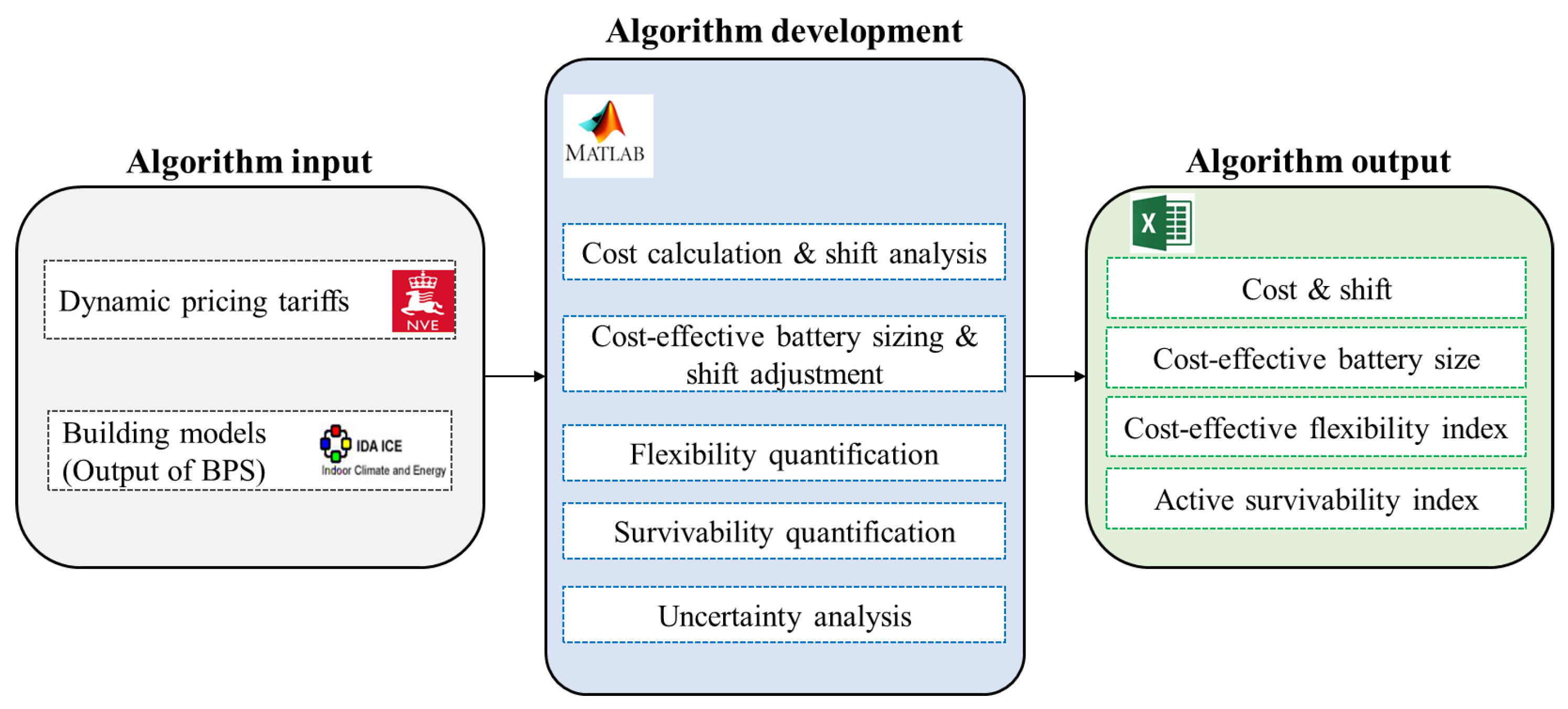
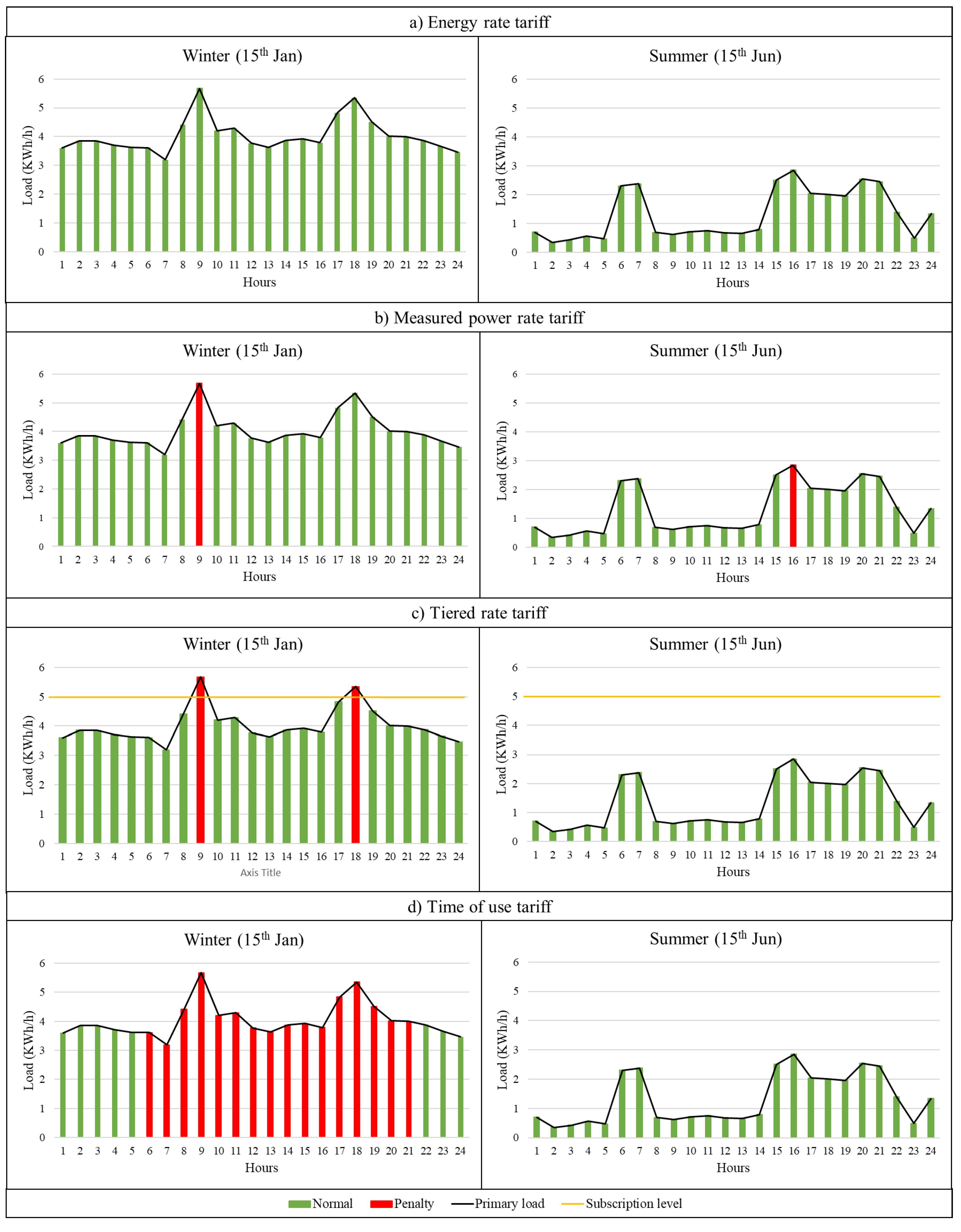
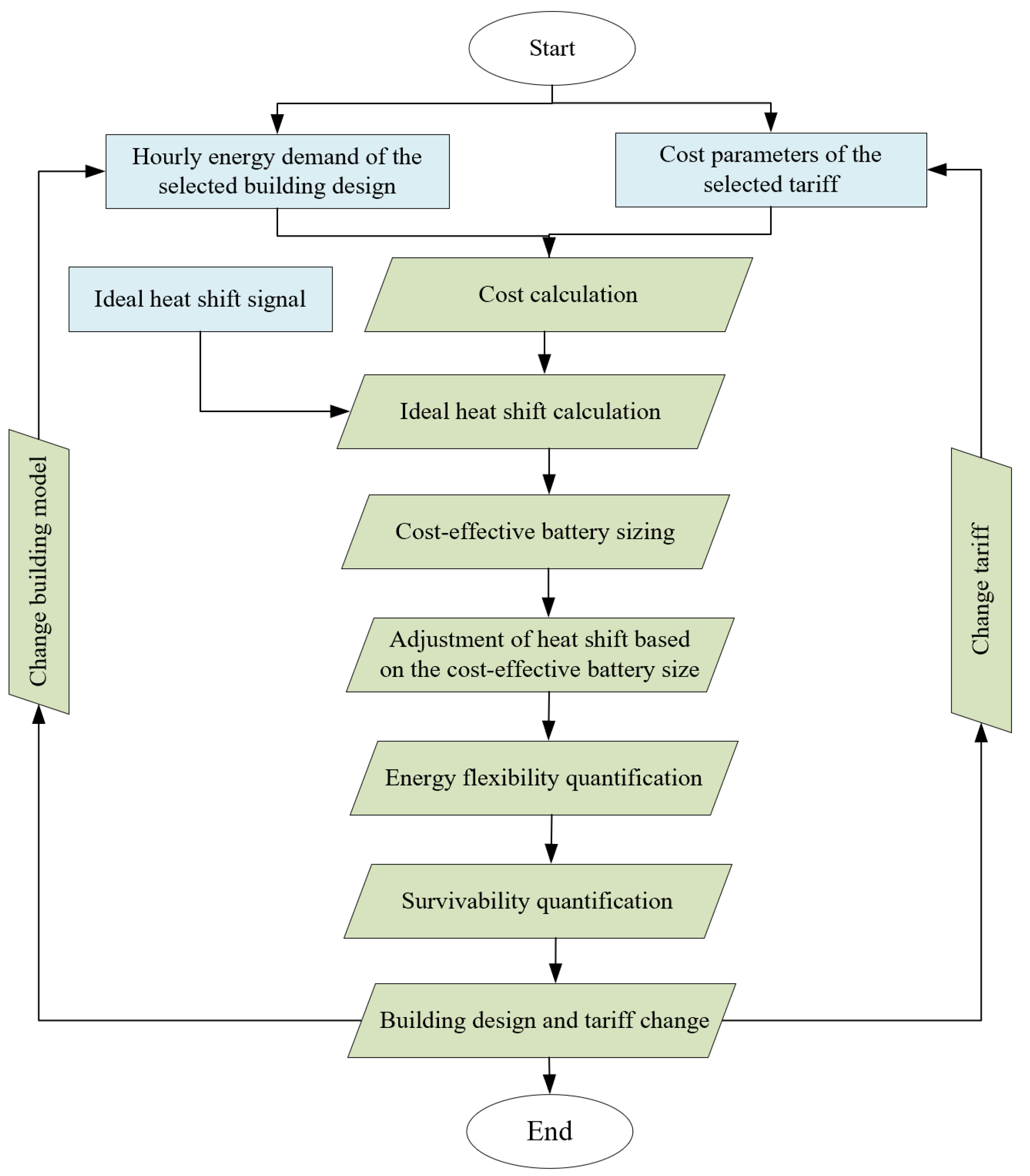
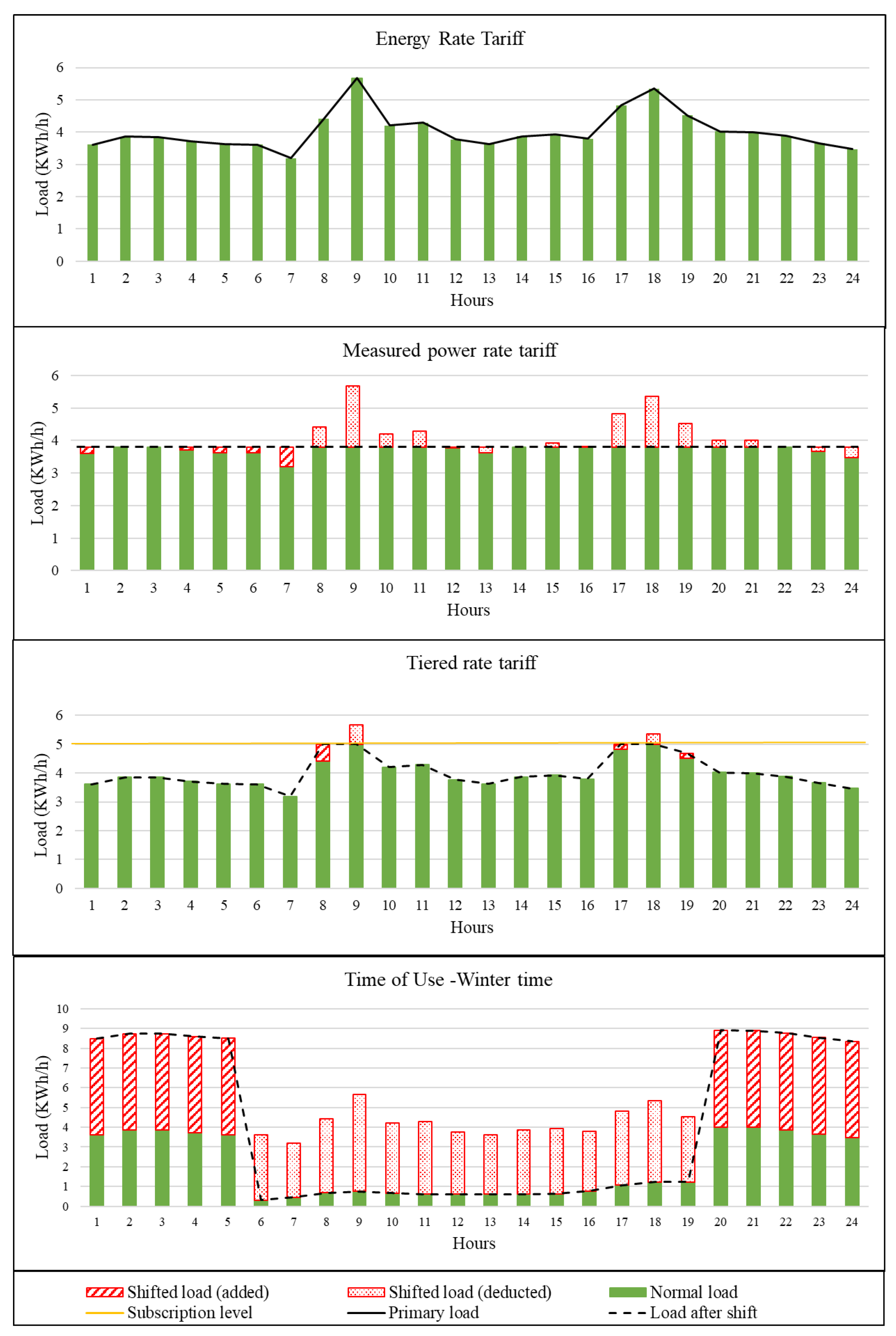
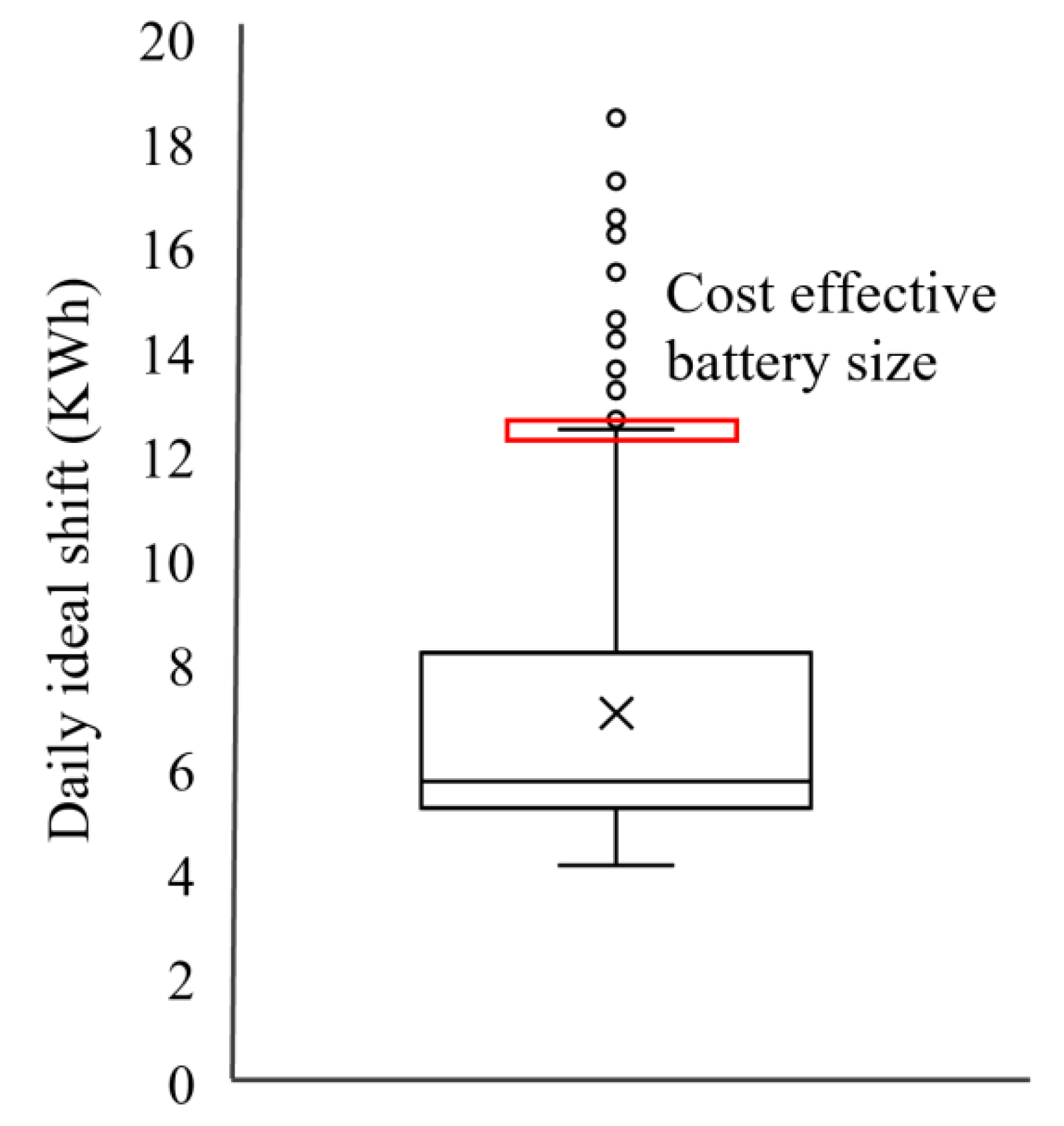
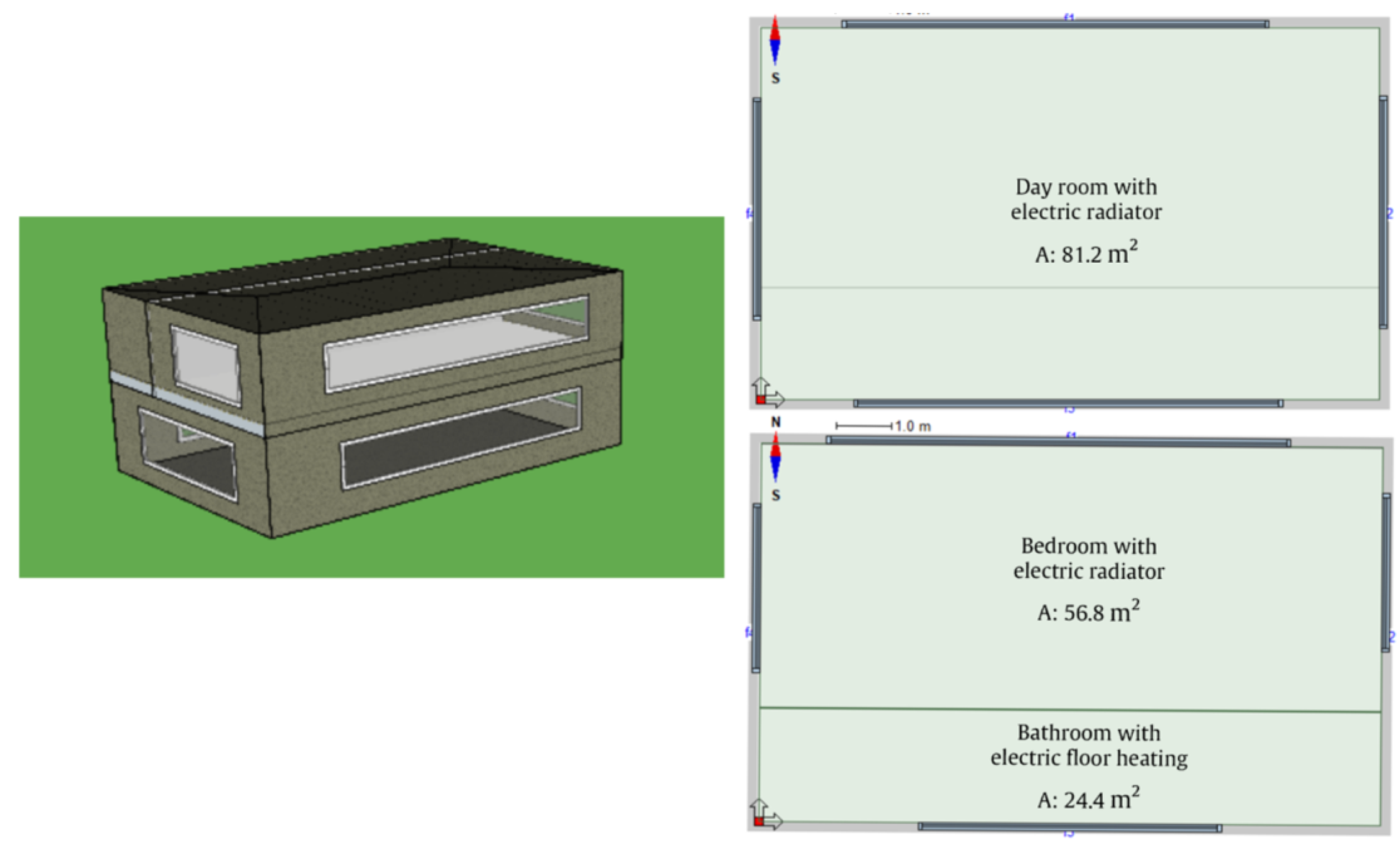

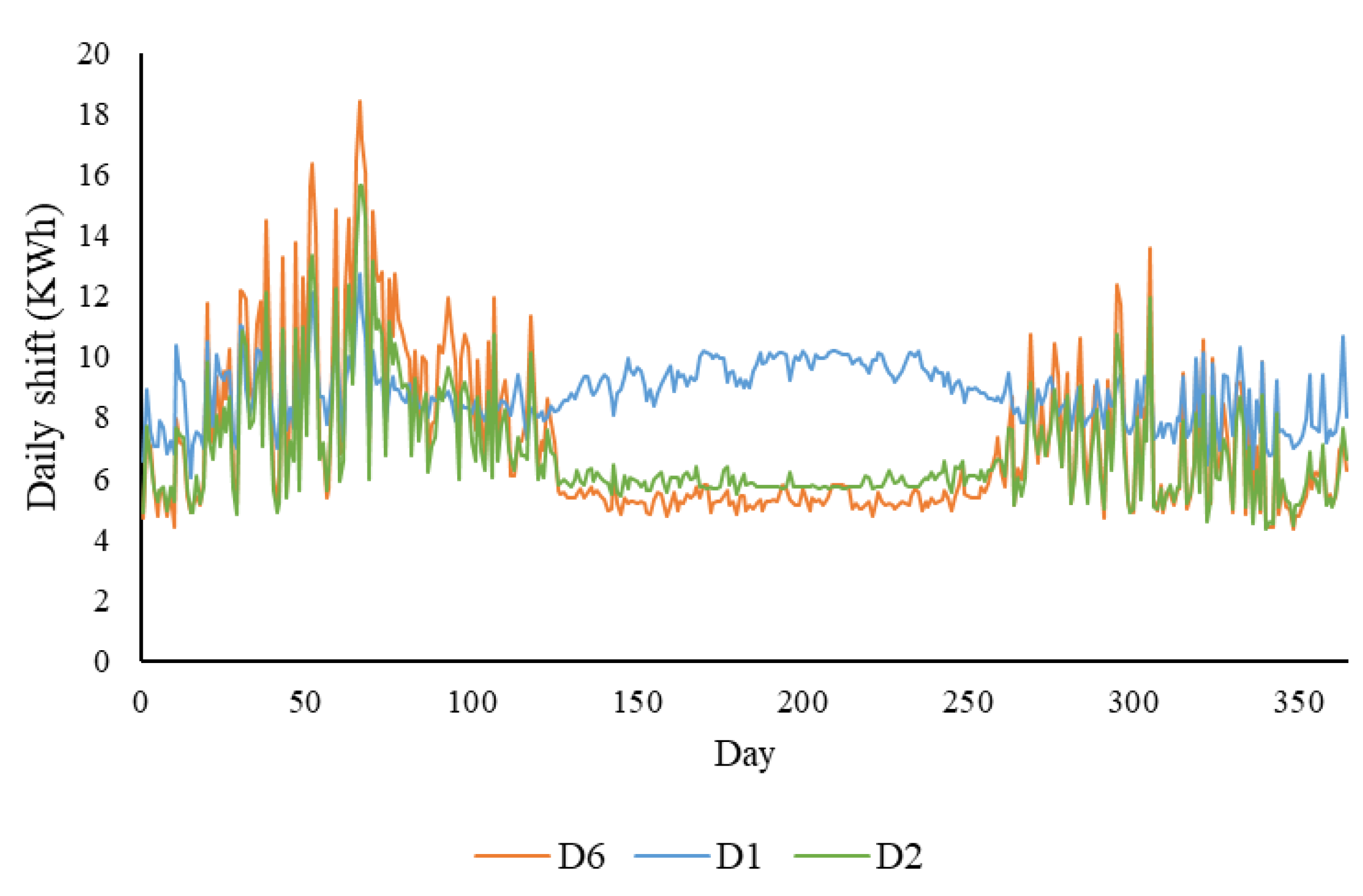
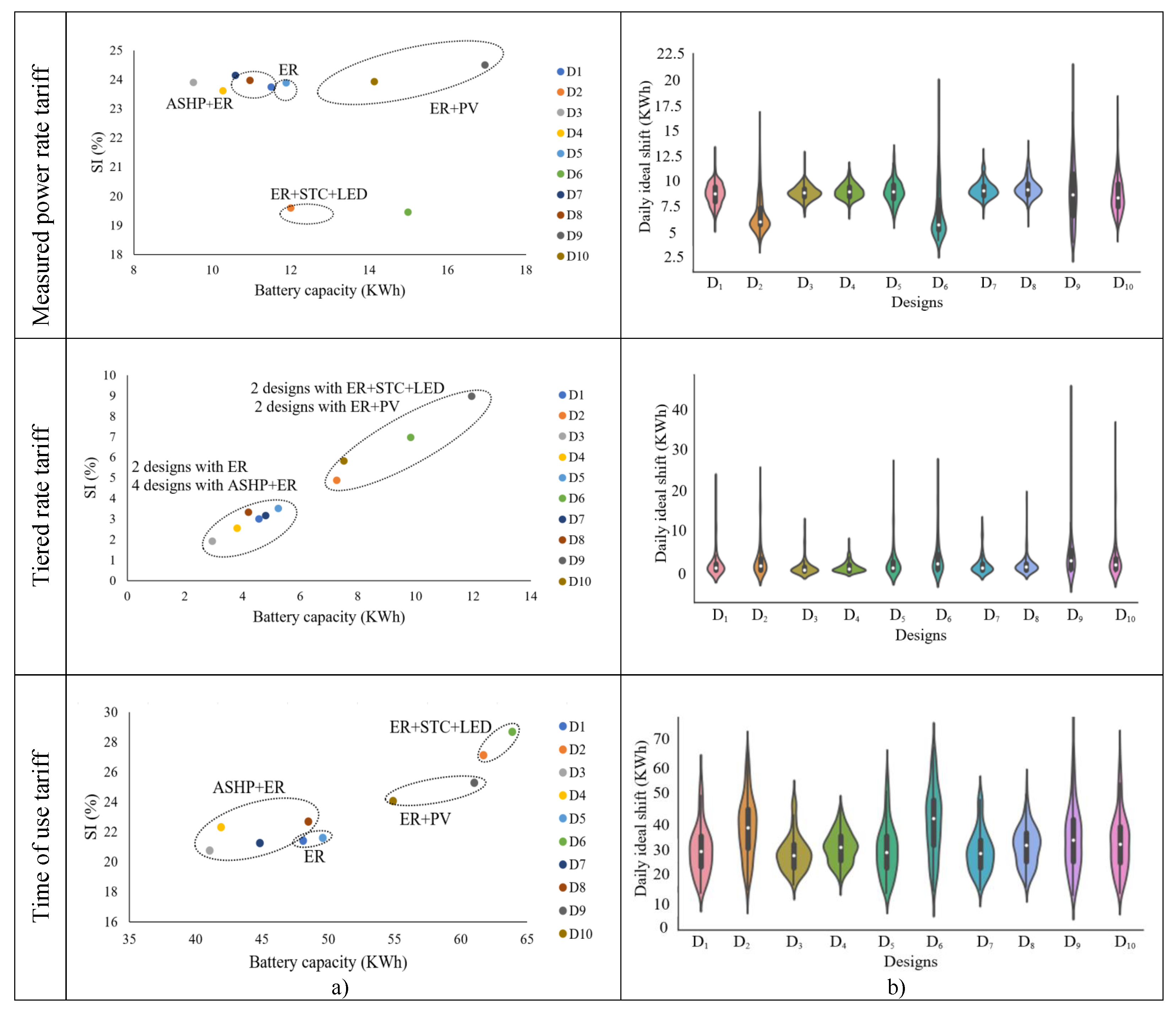
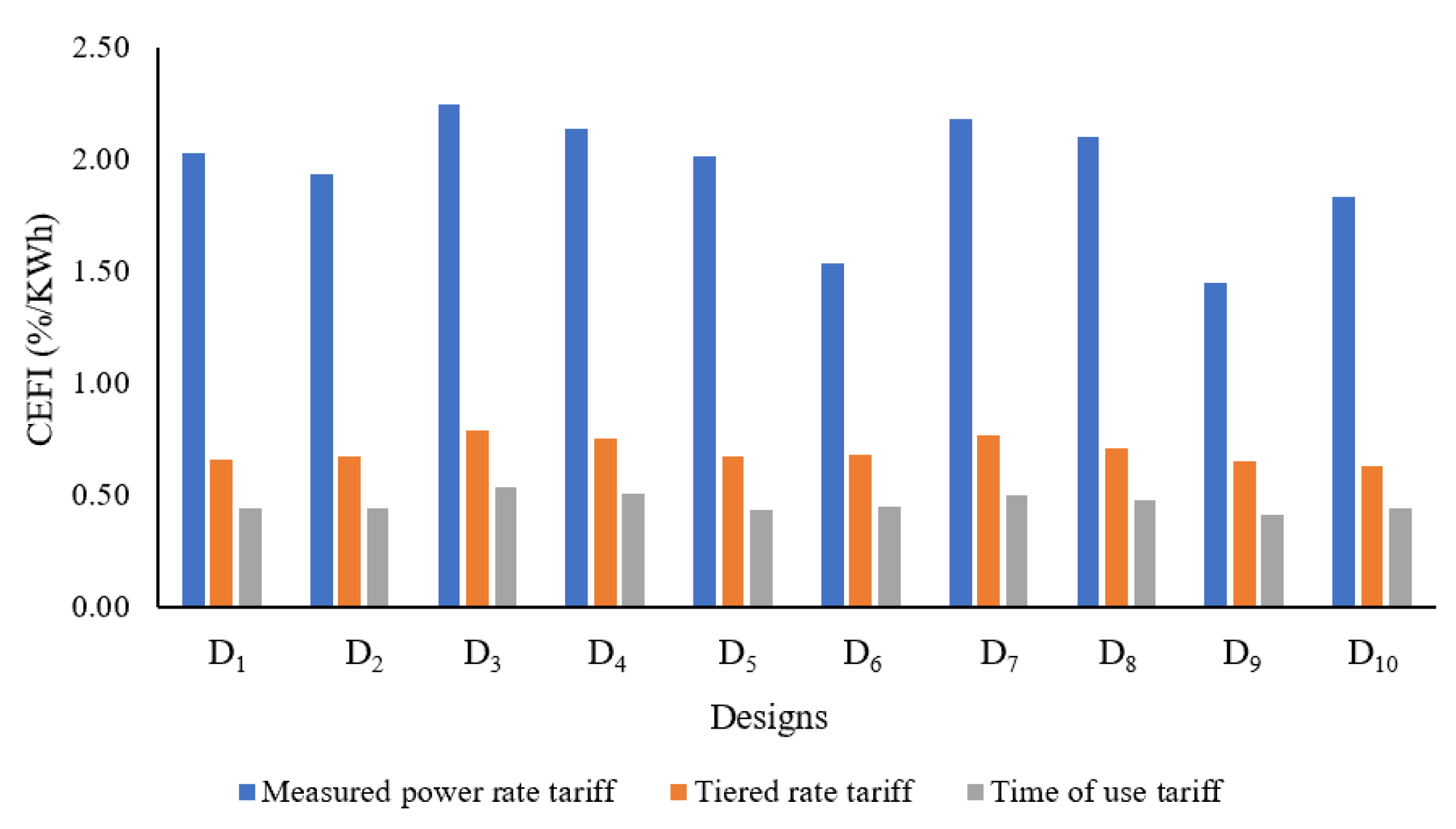
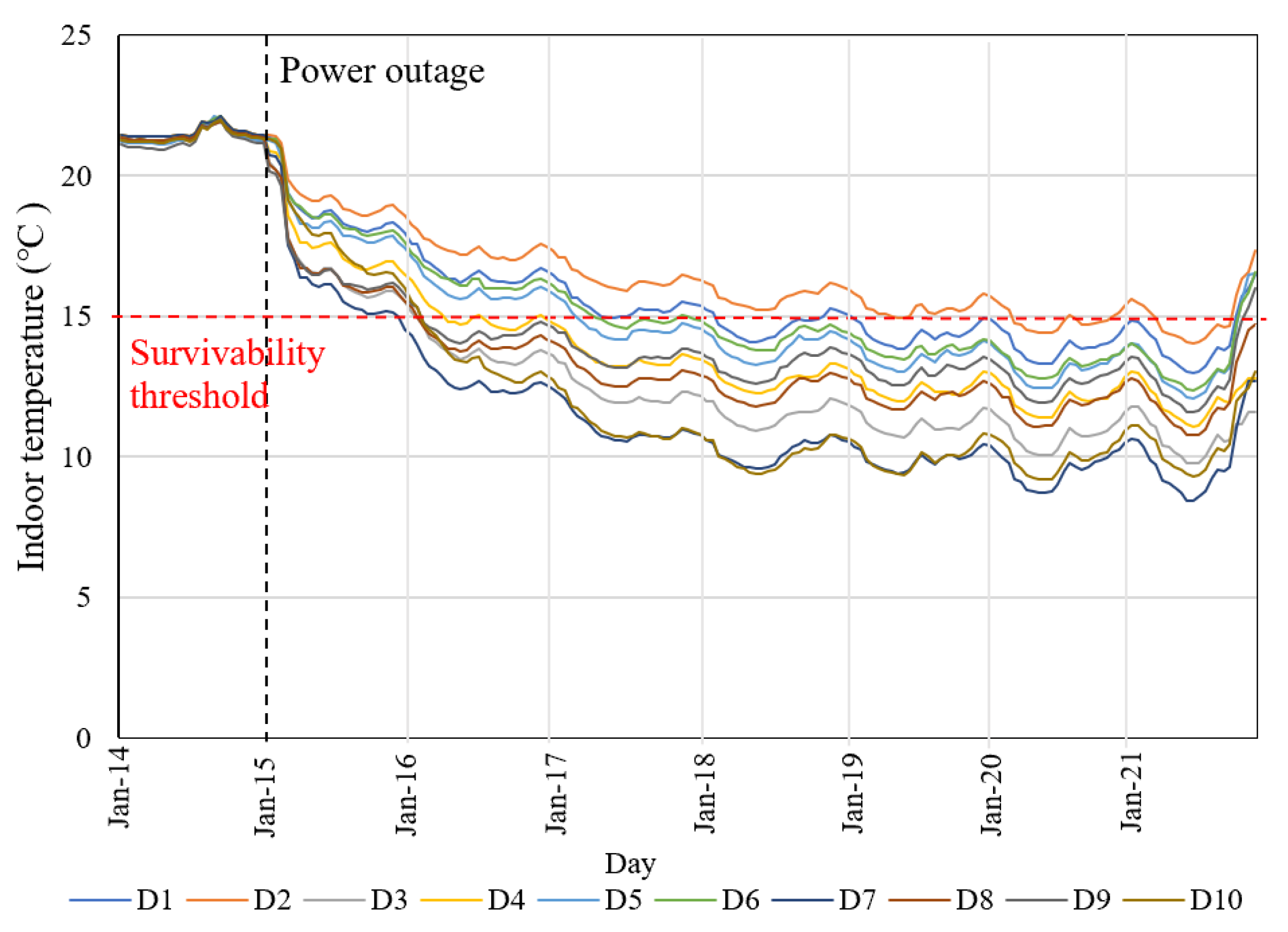
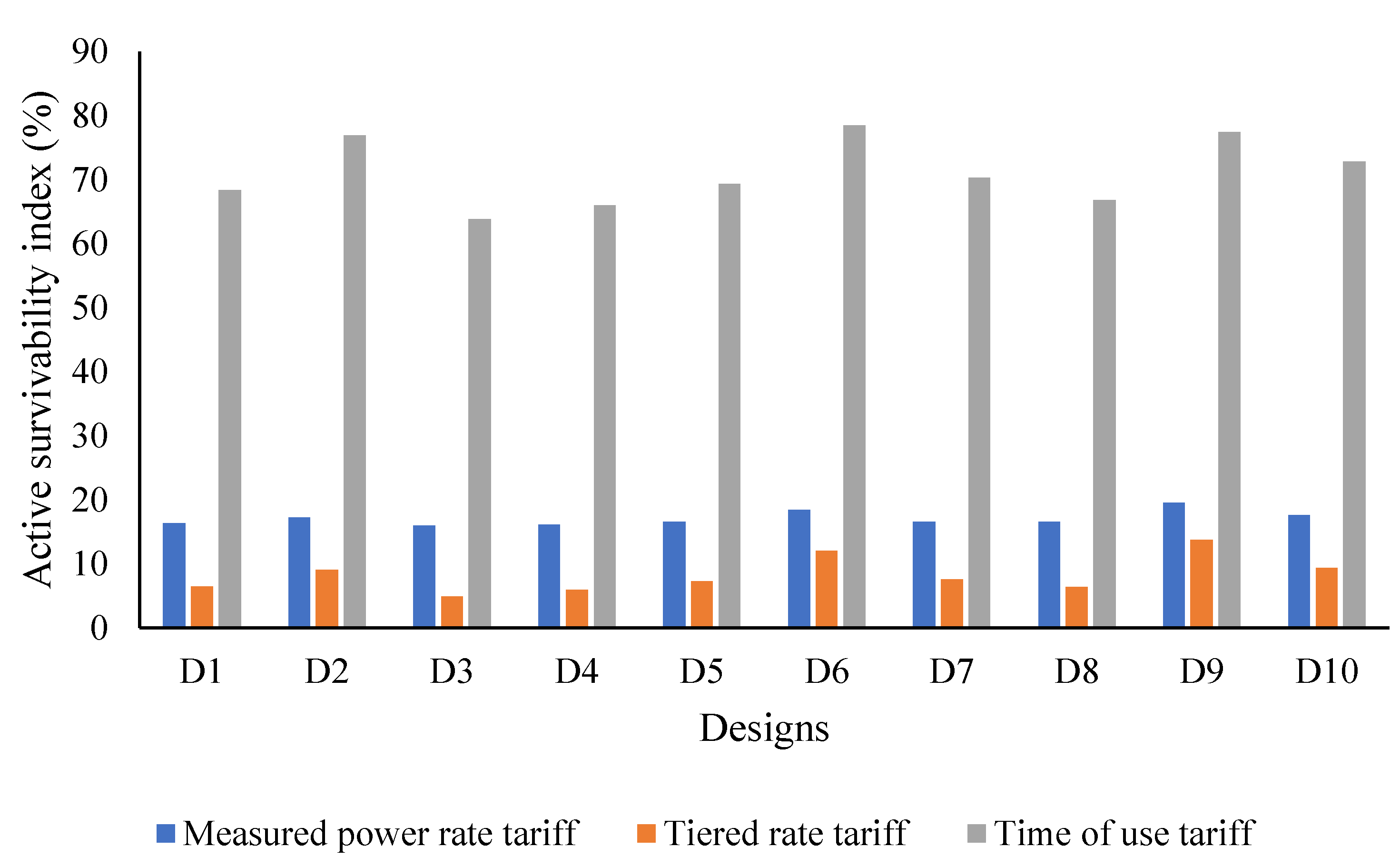
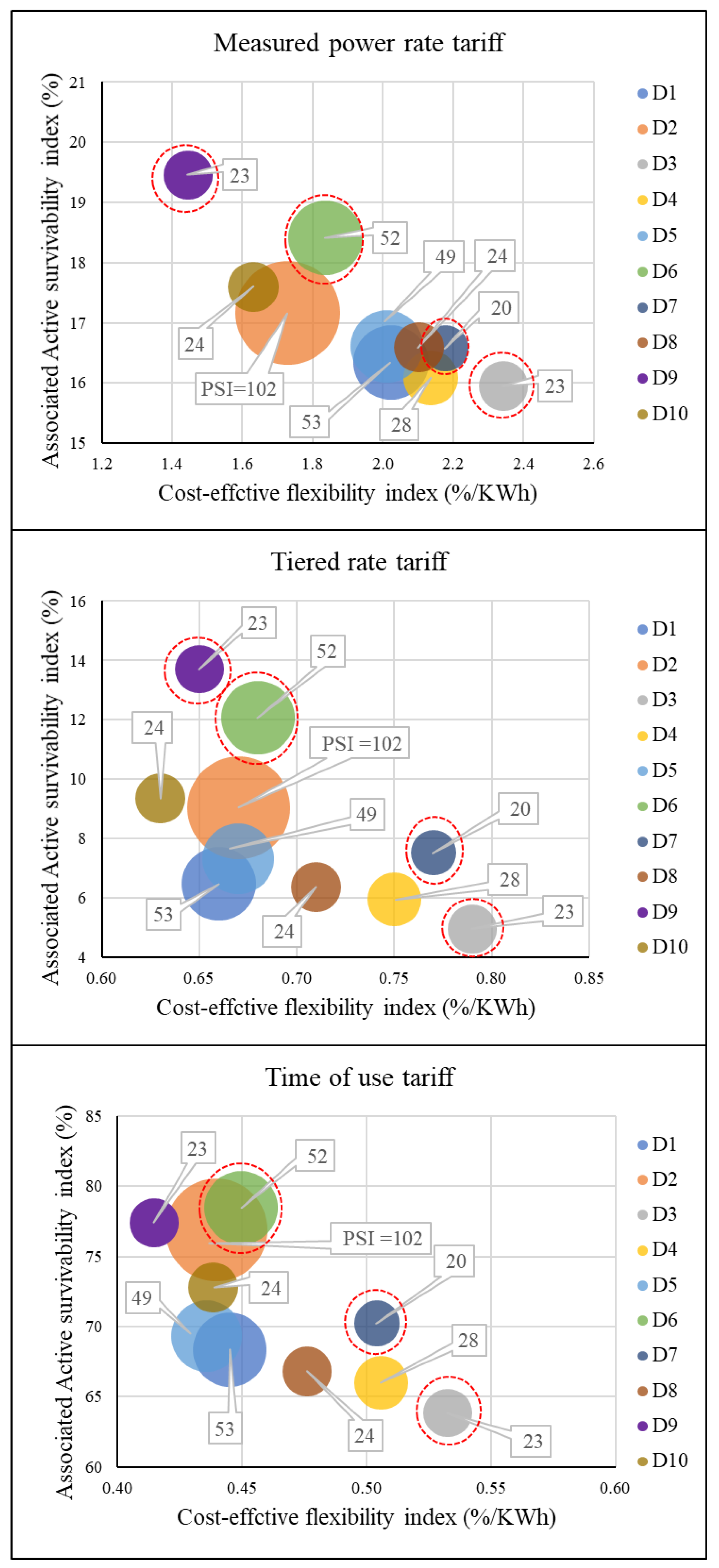
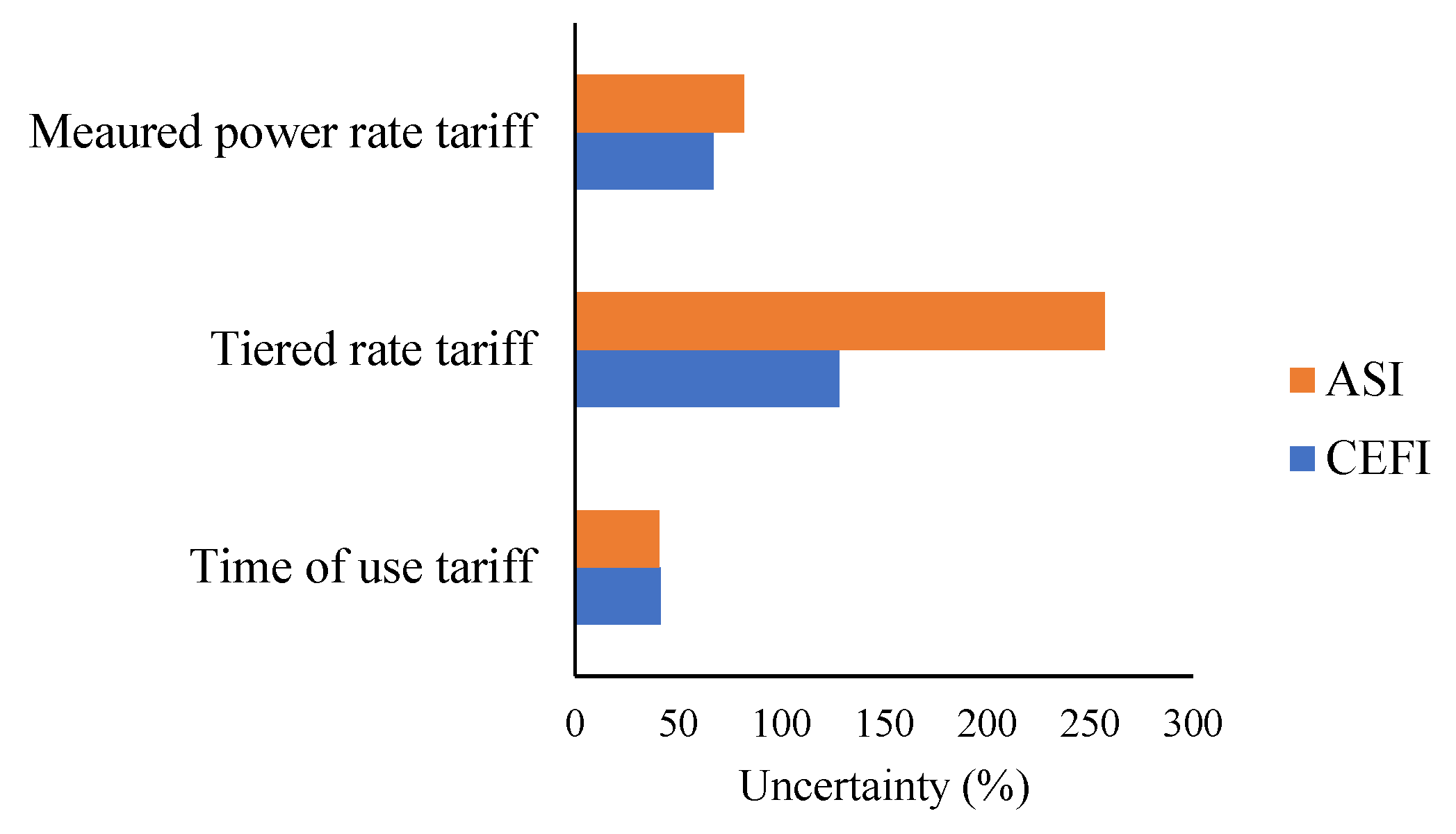
| Energy Rate Tariff | |||
| Fixed cost | Energy cost | - | - |
| (€/year) | (€/kWh) | ||
| 174.9 | 0.0194 | - | - |
| Measured Power Rate Tariff | |||
| Fixed cost | Energy cost | Power cost | - |
| (€/year) | (€/kWh) | (€/kWh/h) | |
| 174.9 | 0.005 | 0.186 | - |
| Tiered Rate Tariff | |||
| Fixed cost | Energy cost | Subscription cost | Overuse cost |
| (€/year) | (€/kWh) | (€/kWh/h)/year | (€/kWh/h) |
| 174.9 | 0.005 | 68.9 | 0.1 |
| Time of Use Tariff | |||
| Fixed cost | Summer energy cost | Winter day energy cost | Winter night energy cost |
| (€/year) | (€/kWh) | (€/kWh) | (€/kWh) |
| 174.9 | 0.0122 | 0.038 | 0.0152 |
| Designs | ||||||||||
|---|---|---|---|---|---|---|---|---|---|---|
| Design Parameters | D1 | D2 | D3 | D4 | D5 | D6 | D7 | D8 | D9 | D10 |
| Overall U-value (W/mk) | 0.31 | 0.25 | 0.43 | 0.36 | 0.33 | 0.29 | 0.51 | 0.44 | 0.40 | 0.35 |
| Normalized thermal bridge (W/mk) | 0.05 | 0.03 | 0.07 | 0.05 | 0.03 | 0.02 | 0.06 | 0.07 | 0.06 | 0.05 |
| WWR (%) | 30 | 30 | 30 | 30 | 40 | 40 | 40 | 40 | 30 | 30 |
| Heating system | ER | ER | ASHP + ER | ASHP + ER | ER | ER | ASHP + ER | ASHP + ER | ER | ER |
| Ventilation system | Balanced | Exhausted | Balanced | Exhausted | Balanced | Exhausted | Balanced | Exhausted | Balanced | Balanced |
| Solar DHW system size (m) | 0 | 5 | 0 | 0 | 0 | 5 | 0 | 0 | 0 | 0 |
| PV system size (m) | 0 | 0 | 0 | 0 | 0 | 0 | 0 | 0 | 40 | 20 |
| Lighting | Typical | LED | Typical | Typical | Typical | LED | Typical | Typical | Typical | Typical |
| KPI | ||||||||||
| Total energy consumption (kWh/m) | 110 | 110 | 110 | 110 | 110 | 110 | 110 | 110 | 110 | 110 |
Publisher’s Note: MDPI stays neutral with regard to jurisdictional claims in published maps and institutional affiliations. |
© 2021 by the authors. Licensee MDPI, Basel, Switzerland. This article is an open access article distributed under the terms and conditions of the Creative Commons Attribution (CC BY) license (https://creativecommons.org/licenses/by/4.0/).
Share and Cite
Homaei, S.; Hamdy, M. Quantification of Energy Flexibility and Survivability of All-Electric Buildings with Cost-Effective Battery Size: Methodology and Indexes. Energies 2021, 14, 2787. https://doi.org/10.3390/en14102787
Homaei S, Hamdy M. Quantification of Energy Flexibility and Survivability of All-Electric Buildings with Cost-Effective Battery Size: Methodology and Indexes. Energies. 2021; 14(10):2787. https://doi.org/10.3390/en14102787
Chicago/Turabian StyleHomaei, Shabnam, and Mohamed Hamdy. 2021. "Quantification of Energy Flexibility and Survivability of All-Electric Buildings with Cost-Effective Battery Size: Methodology and Indexes" Energies 14, no. 10: 2787. https://doi.org/10.3390/en14102787
APA StyleHomaei, S., & Hamdy, M. (2021). Quantification of Energy Flexibility and Survivability of All-Electric Buildings with Cost-Effective Battery Size: Methodology and Indexes. Energies, 14(10), 2787. https://doi.org/10.3390/en14102787








